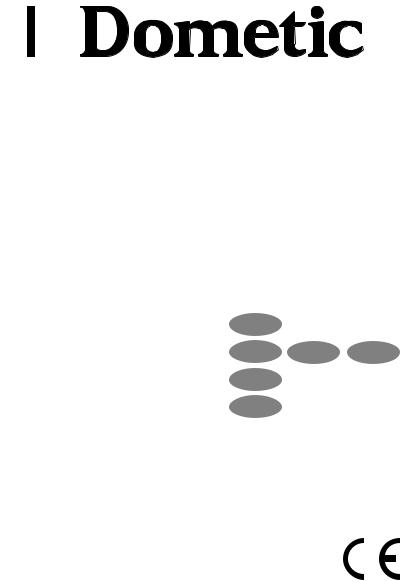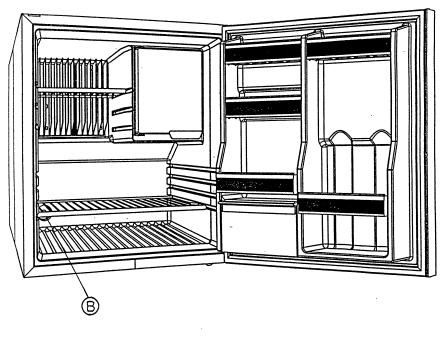Frigidaire R8992A, R90AC Manual

|
|
|
|
A 803 E |
R 8992 A |
RH 080 D |
|
KS 80.1-AM |
|
R 90 AC |
|
Deutch |
Seite |
3 |
DE |
|
Francais |
page |
8 |
BE |
CH |
Italiano |
parte |
14 |
IT |
|
English |
page |
20 |
GB |
|
207.4882.01

Fig. 1.
2

GB
INTRODUCTION
We are pleased that you have chosen this refrigerator and trust that it will be to your complete satisfaction. We should also like to offer some useful tips.
This absorption refrigerator has a (***) freezer compartment (-18°C) for freezing ice and storing deep-frozen food. (These values are maintained at ambient temperatures of between +16°C and +32°C). The normal refrigerator compartment is cooled by a separate evaporator.
Please read these instructions carefully before using the refrigerator.
To obtain good service and ensure that the refrigerator operates economically, it must be used as detailed below.
DAMAGE IN TRANSIT
After removing the packaging, examine the refrigerator to ensure it has not been damaged during transit. Should damage have occurred, please proceed as detailed below.
Transit damage must be reported to the company responsible for transport within seven days, at the latest, following delivery of the goods.
TYPE PLATE
The type plate is afixed to the interior of the refrigerator and bears, amongst other information, the following details:
type
model description product number serial number
This information must be produced should it become necessary to contact customer service. We recommend that you write these details down here. Further technical information can be found in the paragraph entitled TECHNICAL DATA in these instructions.
INSTALLATION
It is important that the refrigerator should not be exposed to heat radiation from hot appliances (e.g. stoves).
To obtain good service, also in the case of high ambient temperatures, it is important that the cooling unit is sufficiently ventilated. The ventilation apertures at the top of the refrigerator must not be covered up.
PUTTING INTO SERVICE
The 230V electricity supply must be provided by a socket earthed in accordance with current regulations. Before putting the refrigerator into service, please ensure that the mains connection voltage corresponds to the voltage indicated on the type plate.

GB
TEMPERATURE CONTROL
An absorption refrigerator operates without making any noise whatsoever. The deep freezer compartment should become cold approximately one hour after being switched on. Six to 10 hours are required for the refrigerator to reach normal operating temperature (dependent on the ambiant temperature). If the refrigerator is stocked with food, the cooling period is longer (8-18 hours).
The thermostat allows continuing temperature control inside the refrigerator. Normally, the regulating knob (B) is set at position 3-5. Should you require a lower (colder) temperature, please turn the knob to a higher level.
FOOD STORAGE
Always store food in closed containers, aluminium foil or in a similar manner. Never place food in the refrigerator while it is still warm, always allow it to cool down to room temperature beforehand.
CAUTION: combustible liquids and gases must not be stored in the refrigerator. There is a DANGER OF EXPLOSION!
The (***) freezer compartment is intended for freezing ice cubes and storing frozen food, for instance, ice cream. It is not suitable for freezing food. Most deep-frozen food, provided it has not been thawed out in the meantime, can be stored in the freezer compartment for a period of up to one month. However, this time period can vary. Therefore, the directions on the packaging must be observed.
FREEZING ICE CUBES
To freeze ice cubes fill the dish with water and place it on the bottom of the freezer compartment. To accelerate the process turn the regulator up to the highest mark. However, do not forget to turn it back again afterwards.
DEFROSTING
When operating normally, the cooling ribs in the normal compartment defrost automatically. In the case of increased air humidity, frost may form on the cooling ribs. Should the frost layer attain a thickness of approximately 3 mm, the refrigerator must be defrosted to avoid impairing the performance level. Even if this is not the case, the (***) freezer compartment must be defrosted on a regular basis following heavy ice formation. This is carried out as follows:
Set the thermostat at ‚0', disconnect at the mains, remove food and ice dish and leave the doors open. Do not expose the refrigerator to external heat and do not attempt to scratch away the frost with sharp objects.
The drained water runs in a groove and from there continues along a pipe through the refrigerator's rear panel and into a collection container on the cooling unit, where the water evaporates by itself. Should the frost layer become very thick, there is a danger of the collection basin overflowing. In this case the water should be absorbed by a cloth placed under the ribs. The water in the freezer compartment should also be absorbed by a cloth.
